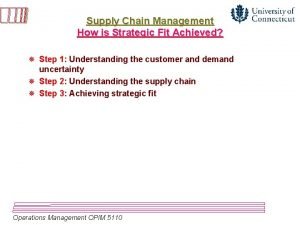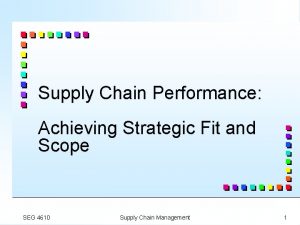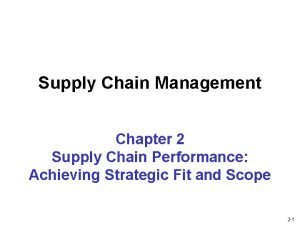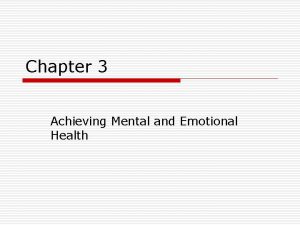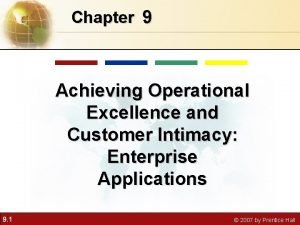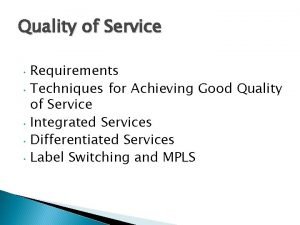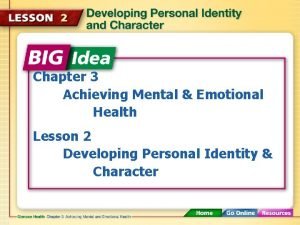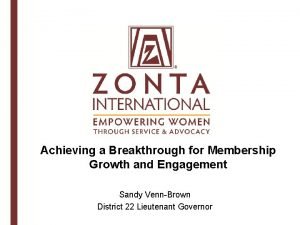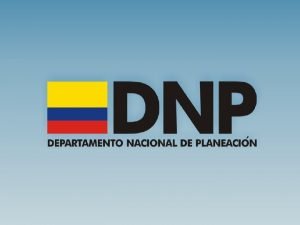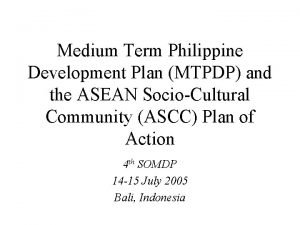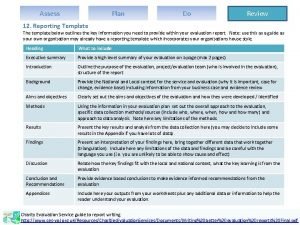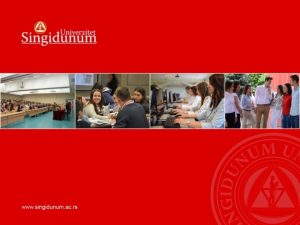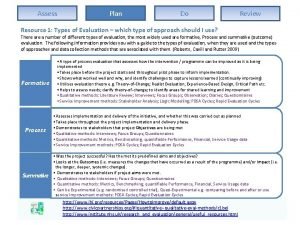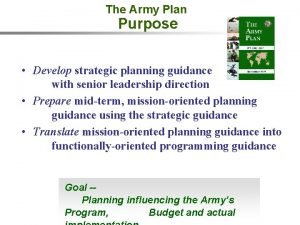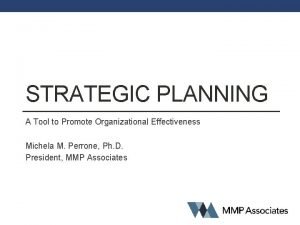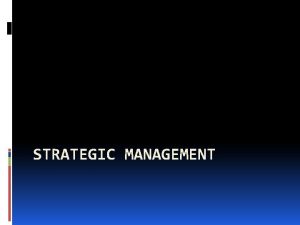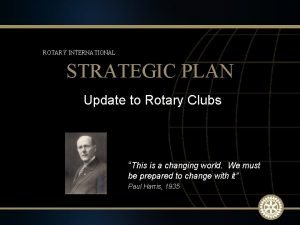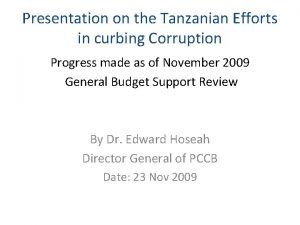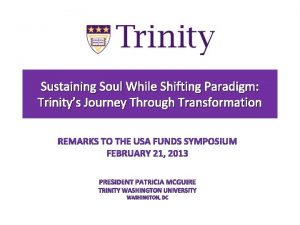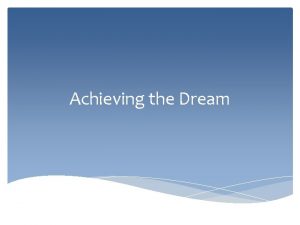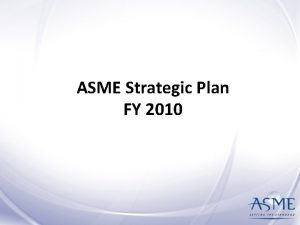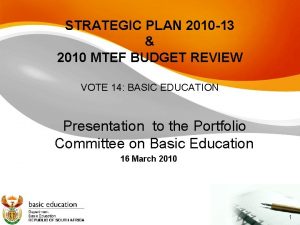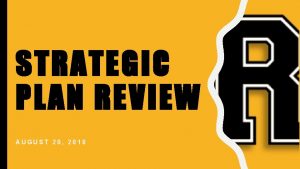2010 Strategic Plan Review Trinitys Strategic Plan Achieving





























































- Slides: 61

2010 Strategic Plan Review

Trinity’s Strategic Plan, Achieving Trinity 2010, is a dynamic document that forms the basis for academic and administrative planning, budgeting, assessment and initiatives. The Senior Executive Staff provide annual plans and assessments linked to the strategic goals. These plans and assessment reports are available on the managers’ website and will be posted to the Periodic Review Report website as well. Management assesses progress on all strategic goals twice a year at senior staff retreats. The Board also reviews the strategic plan annually. Enrollment and financial analysis is a continuous process at Trinity. Strategic Enrollment Reports and Strategic Financial Analysis Reports accompany this presentation in Appendices A and B. As part of the Periodic Review Report due to Middle States in June 2011, Trinity is updating and revising the current strategic plan, and will issue a new version of this plan in July 2011.

STRATEGIC PLANNING DESIGN STRATEGIC ENROLLMENT GOAL (Goal 1) BASELINE 5 -YEAR FINANCIAL MODEL (Goal 2) Enrollment Drivers PROGRAMS (Goal 3) TECHNOLOGY (Goal 4) CAPITAL CAMPAIGN PLAN (Goal 2) Financial Drivers PEOPLE CAPACITY (Goals 5 -6) SERVICE REPUTATION INTELLECTUAL OUTPUT (Goals 7 -8 -9) FACILITIES (Goal 10)

Strategic Goal 1: Enrollment Goal: • By the Year 2010 Trinity University will enroll 3000 students in degree programs as follows: • 600 undergrad students in the College of Arts and Sciences • 750 graduate students in the School of Education • 1, 650 students in the School of Professional Studies including: • 200 in Associate Degree Programs • 200 in Health Professions Programs • 800 in general baccalaureate Program • 200 in the MBA Program • 250 in other graduate programs Revised Goal Statement: By 2015 Trinity will enroll 3000 students in degree programs as follows: 1100 CAS 1000 SPS 370 EDU 535 NHP See “Strategic Enrollment Projections” Powerpoint (Appendix A) for further analysis

Strategic Goal 2: Finances Goal: Coordinate with Strategic Goal 1 – Enrollment, Trinity has created a five-year financial model with analytical detail on revenues and expenses related to the enrollment goals. This model is a companion document to this strategic plan. Trinity will use the Critical Financial Monitoring System to benchmark financial performance against these strategic financial goals for Trinity 2010: • • • Measure Benchmark Annual Operating Margin Greater than 2% (Moody’s) Return on Net Assets Greater than 8% (Moody’s) Viability Ratio Greater than 1% (Moody’s) Direct Debt to Total Capitalization Less than. 3 Cushion Ratio Not less than 4. 0 (Bond Covenant) Debt Service Coverage Not less than 1. 0 (Bond Covenant) Bad Debt Not to Exceed 2. 5% of receivables Ratio 5% improvement per year Tuition Dependence Not greater than 80% 2011 Objectives: • • • Repeat significant surplus performance Meet all current debt covenants Prepare for new building financing • Continue improved performance against benchmarks • Launch capital campaign to strengthen longterm fiscal margins and improve borrowing capacity for building program See Strategic Financial Ratios and Financial Planning (5 year proforma) materials (Appendix B)

Strategic Goal 3: Program Development GOALS: Progress: College of Arts and Sciences: College of Arts & Sciences: ü Successful reform of general education already showing improved learning outcomes for underprepared first year students ü Still need to develop more distinctive track for women’s leadership beyond the general exposure to the supportive environment for women leaders ü Some multi-disciplinary endeavors underway but need more clarity about the opportunities and return on investment ü Continue to strengthen glidepath between liberal arts core and preparation for professional majors in health professions, business, education and human services fields • • • Reform of general education Development of a more rigorous focus on demonstrable outcomes of undergraduate education for urban learners A more distinctive expression of Trinity’s commitment to developing women’s leadership abilities Development of key programs that can serve as organizing forces for multiple disciplines: Intelligence Studies, Health Professions, Psychology and Human Relations, Business and Economics, Communication; Incorporation of web-enhanced instruction

Strategic Goal 3: Program Development GOALS: Progress: School of Professional Studies • ü • • Development of a more distinctive focus on undergraduate education for adult professional learners, Development of a comprehensive network of student services particularly designed for adult learners Further Development of key programs: – – • • Nursing and Health Professions Sports-related Academic Programs Information Technology Business Administration Associate Degree Programs Development of off-site and employer-based programs, including increased programming in southeast Washington at THEARC, establishing locations in downtown Washington, and exploring site potential in Maryland Virginia. ü ü ü Strengthen academic profile of the unit in all programs Develop more targeted undergraduate majors related to employer demand Need to strengthen MBA Program and to focus on a clearer market niche for this product Need to strengthen MSA Program and complete planned reform to refocus degrees on specific topics Need to leverage THEARC location to expand program offerings Identify specific programs for online and executive format delivery Develop significantly more distinctive identity and reputation around: o o o Criminal Justice Media Studies/Communication Accounting Marketing Specific management disciplines: o o Nonprofit – strengthen, add both undergrad and CED Human Resources

Strategic Goal 3: Program Development (CONTINUED…) Goals: (continued…) School of Education: • Development of a more distinctive focus on the preparation of teachers leaders for urban school settings; • Creation of an online master’s degree for teachers, and development of online and web-enhanced capacity for teacher professional development; • Further development of the Educational Technology Leadership Institute with a specific focus on developing credentials (certificate and degree) for master teachers in the field of educational technology; • With NCATE accreditation, expansion of the market for students in EDU beyond the immediate school systems (DC, Prince Georges, Montgomery County) to recruit teachers and administrators from other jurisdictions; • To enhance more regional and national recruiting, development of executive-format summer and weekend programming in select topics to provide convenient formats for target populations. Progress: School of Education: In Fall 2010 Trinity will undertake a strategic review of the School of Education in concert with the NCATE accreditation moment and pervasive changes in K-12 education and teacher preparation nationally Develop plan for expansion of the unit to include Human Services/Behavioral Sciences including expanded Counseling, adding Social Work, possible addition of master’s level Psych Launch: o Online EDAD o AA for Teacher Aides o Teacher Quality Program

Strategic Goal 3: Program Development (CONTINUED…) • In the spirit of this goal, we are now adding the next unit; NHP… School of Nursing and Health Professions Launched in Fall 2010, this unit will focus on these issues and develop plans for the new programs: o Strengthening/stabilizing the prelicensure programs o Develop Nursing second degree o Launch RN-to-MSN o Develop MSN specialties o Develop Plans for Allied Health programs: o o Occupational Therapy Speech Language Pathology Exercise Science Health Informatics or other related

Strategic Goal 4: Technology Goal: Progress: Trinity will maintain a “state of the art” campus technological environment, including: Objectives for 2010 -2011: • • • § Continue promotion of faculty proficiency in the use of Moodle and related digital pedagogy tools § Secure leadership for Trinity. Online § Build and Deliver programs through Trinity. Online § Develop improved instructional design capacity § Recruit head librarian for leadership in transformation of the library with technological tools and creation of the vision for the future library § Refresh classroom technology § Enhance campus capacity for pervasive wifi access Maintaining a central depository for all organizational units and continue to enhance the system capabilities for growth and promotion of the institution; sustaining and modernizing the current data center infrastructure to account for the increased demand for information and to ensure data integrity; § Develop greater student capacity for use of tech tools for academic purposes § Digitize student publications § Transform website Development of faculty and staff educational opportunities to keep the workforce apace with technological developments. § Ongoing faculty/staff training To support the curricula and academic programs: increasing the availability and use of new technology in the learning environment to enhance the educational experience, including expansion of online and web-enhanced learning, and further development of Smartrooms and other academic technologies; Development of the Library and Information Resource plan with a greater reliance on the use of technological tools for learning and research; Improvement and expansion of the Trinity website and web tools to increase communication and interactivity to support enrollment, advising services, instructional delivery, marketing and communication among all constituencies;

Strategic Goal 5: Human Resources Goals: Progress: For the Faculty: Objectives for 2011: • § Completion and beginning implementation of faculty rubrics project § Establish targets for enlargement of faculty size in specific disciplines § Adjunct compensation plan § Faculty Handbooks § Creation of a more robust faculty development program --- revitalize CTLE § Continued development of Staff assessment system § Continued development of Trinity Institute staff development program • • Alignment of the size of the full-time and part-time faculty in each school to the size of enrollments in programs, consistent with disciplinary standards Continuing improvement in full-time faculty compensation aligned with benchmarks; Creation of a compensation plan for adjunct faculty that recognizes and sustains academic talent; Development of a more comprehensive faculty development program Development of the Faculty Handbook policies in relation to contemporary realities for workload, delivery systems, technological innovation and professional development. For the Staff: • • Continuing development of the staff performance assessment system Continuing development of the staff professional development programs to improve staff knowledge, skills and competencies in supervision and management, technology and applications, teamwork and project planning, Development of the Wage and Salary Plan to provide greater flexibility in the recognition of staff performance tied to goals; Promotion of a climate for innovation and crossfunctional teamwork among all administrative departments, and with faculty, to improve Trinity’s ability to recruit and retain students successfully.

Strategic Goal 6: Management Capacity Goal: Objectives for 2010 -2011: • With the leadership of each academic dean, a plan for the development of academic advising and other services to support each academic unit will specify the additional knowledge, skills and competencies necessary to manage the units successfully in fulfillment of unit performance goals; • Development of the core administration for Academic Affairs through strengthening the Provost’s Office and respective dean’s offices • Ensure adequate succession planning for each key executive position With the leadership of the senior executive staff, every subsidiary division and department will specify in their annual plans the knowledge, skills and competencies necessary to manage each division and department successfully in fulfillment of performance goals; • Develop key learning objectives for members of the senior executive staff to improve overall leadership and management excellence for Trinity • Identify strategies to assist all managers in maintaining a disciplined focus on achieving objectives and goals, avoiding time traps and spending too much time on minor issues • Strengthen the ability of the executive team to engage in real planning and assessment as an ongoing part of their duties • • • Supervisors will receive ongoing education and training in management techniques to improve their ability to focus on achievement of goals and objectives; Senior managers and executives will also participate in ongoing education and training to improve their ability to lead the staff and faculty teams to fulfillment of all goals.

Strategic Goal 7: Intellectual and Informational Resources Goal: Trinity will increase its attention to scholarly and professional productivity in these ways: • • Objectives for 2010 -2011: • Establishment of a clearinghouse for faculty and staff access to the scholarly and professional development work of colleagues Creation of a more distinctive and affirmative vision for the intellectual life of Trinity must be a top priority • Creation of a more distinctive focus on the importance of active contributions to the knowledge base Take the work already begun in CAS on student retention and improved performance and turn it into a national model • Each academic unit must articulate a sense of mission, vision and priorities that link to Trinity’s goals and that will establish that part of Trinity as a major player in the respective disciplines and professional fields • Identification of specific incentives to improve intellectual productivity • Enhance institutional focus on the development of the informational resources necessary to support the teaching and learning enterprise • • With the leadership of the Librarian and Vice President for Academic Affairs, Trinity will establish an annual operational plan for the acquisition, maintenance and use of library and informational resources, and general collection development; Faculty and staff participation in external opportunities for scholarship and presentation of Trinity’s work to other audiences needs enlarged focus • Student publications must become a more important part of campus life • See the goals for library --- it’s time to get moving on this! • With the leadership of the Librarian, Vice President and President, Trinity will develop a strategic plan for the development of the Library and its resources that reflects the best thinking of contemporary academic libraries, and this plan will guide the development of the University Academic Center’s library and information resource components.

Strategic Goal 8: Service to Students and the Community Objectives for 2010 -2011 Goal: • • • Trinity will extend its educational and service talent to children, families and adults in neighborhoods, schools, civic organizations and other locations in the District of Columbia and the Washington Region. Through the Trinity Center for Women and Girls in Sports, Trinity will continue to offer wellness, fitness, recreational, educational and athletics programs and services to the larger Washington community as well as to the campus community; the annual plan for the Trinity Center includes measurable goals for these services; For the campus community, Trinity will create annual plans with measurable goals for service delivery and effectiveness, and customer satisfaction, in these areas for all schools: – – Academic Support Services, Health Services, Campus Ministry, Residence Life Student Government , Student Activities Enrollment Services Food Service, Bookstore, Facilities Services • All departmental assessments will include specific components for student satisfaction • Development of a more comprehensive view of the needs of each student population and likely sources of services to meet those needs • Expansion of programs in Wards 7 and 8 consistent with the interests of funding sources • Expansion of programs at THEARC • Revitalization of service learning and community service programs • Through development of NHP consideration of ways in which Trinity might become a health services provider in the community (possible clinical components on campus)

Strategic Goal 9: Quality Outcomes and Key Performance Indicators Goal: • Consistent reporting of results against the strategic goals on a regular timetable will enhance Trinity’s ability to focus on improving outcomes. • Beyond the specific unit-by-unit and goal-by-goal statements of outcomes and key performance indicators, Trinity will also establish overall institutional plans and quality goals • Creation of a nationally-recognized First Year Program for the successful development of first year students who present preparatory challenges at entrance • Establishment of a model program for student learning outcomes assessment • Development of an Enrollment Management model that focuses on improving retention and completion • Implementation of a longitudinal assessment system that is able to track alumnae/i outcomes • Creation of a service response system for all departments that improves Trinity’s reputation among all constituencies for the quality, timeliness and effectiveness of service delivery; • Promotion of a more vigorous public image for Trinity through more effective use of media to report the accomplishments of faculty, students, staff and alumnae. Objectives for 2010 -2011 Create a more deliberate mechanism for taking the metrics already developed to a level that will permit their publication to various audiences…

Strategic Goal 10: Facilities and Campaign Planning Goal: By the Year 2010: • • • Construction of the University Academic Center will be underway and nearing completion. Construction of new/renovated residential facilities will be underway; Facilities upgrades for fire and life safety purposes will be continuous; Objectives 2010 -2011: • Academic Center Concept Design Approved November 2010 • Capital Campaign Plan Approved November 2010 • Capital Campaign underway Sp 2011 • Main Hall Elevator Project plan In process Spring 2011 • Notre Dame Chapel repairs In process • Alumnae Hall residence hall Opened Fall 2010 • New Housing Planning Target for Fall 2011 Improvements in Main Hall infrastructure will be continuous; Completion of the Alumnae Hall Campus Center Project will be on the drawing board. In order to achieve the University Academic Center and other facilities goals, Trinity will plan a major capital campaign to raise no less than $50 million in support of facilities projects during the period 2007 – 2012.

APPENDIX A: STRATEGIC ENROLLMENT ANALYSIS

STRATEGIC ENROLLMENT MODEL UPDATED SPRING 2011 Note: These projections, updated each semester, provide the basis for the fiveyear financial proforma, and also the basis for strategic program development.

STRATEGIC ENROLLMENT PLANNING Headcount 2010 -2015 Fall 2010 CAS SP 2011 934 Fall 2011 925 SP 2012 1005 Fall 2012 908 SP 2013 1044 Fall 2013 947 SP 2014 1087 Fall 2014 981 SP 2015 1108 Fall 2015 991 1103 SPS AA 74 68 80 76 74 76 79 75 74 73 73 SPS UG 468 476 455 425 447 429 454 440 442 440 447 SPS GR 245 277 286 322 337 335 354 338 349 334 93 93 104 120 135 143 158 165 174 206 202 SPS MBA NHP NRS 116 102 150 153 168 25 35 57 62 90 97 103 100 104 30 25 52 47 53 57 73 30 42 61 65 65 100 91 104 106 125 NHP OTM NHP RNMSN TOTAL 2309 25 45 367 2273 151 137 NHP OTA 122 364 110 379 98 NHP EX EDU 63 335 2436 384 2340 88 360 2678 384 2604 360 2906 371 2803 350 2978 369 2890 3063

2906 2678 2309 2436 2273 2340 2978 2803 2604 2890 3063


30% growth projected 2010 -2015 2% 3% 8% 10% 5% 2906 2678 2309 2436 2153 2340 2604 3063 2978 2803 2890

NUMBER OF STUDENTS 2305 74% increase in headcount since Fall 2001, 40% since Fall 2007 2034 1645 1637 1736 1659 1618 1640 1605 1519 1565 1327 CAS 127% INCREASE 1690 2039 2272

KEY FACTORS SUPPORTING TRINITY’S GROWTH SINCE 1999: MILLHISER CHALLENGE FOR TRINITY CENTER 2001: KRESGE CHALLENGE 2000: BOND ISSUE GROUNDBREAKIN G CENTENNIAL ENDS 2004: Centennial Campaign Concludes @ $12. 2 million 2003: TRINITY CENTER OPENS 2006: NURSING PROGRAM BEGINS 2006: STRATEGIC PLAN ‘ACHIEVING TRINITY 2010” DRIVES PROGRAMMATIC EXPANSION 2004: “UNIVERSITY” BECOMES PART OF TRINITY’S NAME 2000: STRATEGIC PLAN “BEYOND TRINITY 2000” REORGANIZES TRINITY INTO THREE ACADEMIC UNITS 2000: DC TAG DC CAP 2007: CAS NEW FIRST YEAR AND GEN ED 2002: START MODERNIZATION OF FINANCIAL SYSTEMS, IMPROVED FINANCIAL MANAGEMENT, CONVERSION OF INFORMATION PLATFORM DC BON/CCNE accredit NCATE first accreditation Middle States Reaccreditation 2010: CONCEPT DESIGN AND NEW CAMPAIGN PLAN 2007 -2010: OTHER NEW PROGRAM ELEMENTS: CRIMINAL JUSTICE, ISS, MOODLE PLATFORM XPANSION OF HYBRID OFFERINGS 2010: SCHOOL OF NURSIN G AND HEALTH PROFESSIONS LAUNCHED

GROWTH SCENARIO TO 2015 41% 1640 30% 3000 2305 MSN ONLINE NHP 535 NHP 361% 116 SPS 882 1056 46% (includes nursing start-up) 20% EDU 0% 369 379 17% 48% CAS 934 1103 18%%

Sketch of Strategic Tactics for Enrollment Growth Fall 2010 Unit Online 2009 ENRL 2000 2010 ENRL 2300 0 2015 GOAL 3000 125 Addition to Current 762 125 Tactics Resources Needed Return Expected MSN: 125 OTHER (possible “other” includes EDAD, web design, media studies, Homeland Security) Tech Capacity Should return positive margin if enrollment goals met on the project timetable; low cost after personnel and software acquired Instructional designers NHP 0 116 410 294 Add: Allied Health Programs: Exercise science, OT, Speech Language Pathology Faculty Science Labs Health Labs Investments in sciences for health professions improve CAS science offerings leading to improved enrollments SPS 860 882 1056 174 Evaluate: Undergrad Majors Add: Digital Media Studies Improve: MBA and Ms. A Enlarge: Security Studies, Criminal Justice Develop: Contract Programs, off-site programs Faculty Classrooms Need more suitable social spaces for adults Low cost beyond faculty expense; potential high yield programs EDU 330 379 369 0 Add: Educational Policy Major, possible MSW Enlarge: Counseling Program Expand: Continuing ed Faculty Classrooms Instructional labs No growth forecast until strategic issues for teacher education get resolved CAS 810 34 1103 169 Add: Digital Media Studies Enlarge: Criminal Justice, Psychology, Business FOCUS: RETENTION Faculty Res Halls Labs Classrooms FT students= greatest yield Retention key to sustaining goals

Retention Analysis

Because enrollment planning also requires intense focus on retention, the following slides track Trinity’s retention data since Fall 2006, and then present projected retention sets through 2015






APPENDIX B: STRATEGIC FINANCIAL RATIO ANALYSIS

STRATEGIC FINANCIAL RATIO ANALYSIS Addresses four key financial ratings factors used by Moody’s to evaluate colleges & universities: 1. 2. 3. 4. Financial Position Operating Performance Debt Position/Leverage Liquidity

STRATEGIC FINANCIAL RATIO ANALYSIS Adopted Moody’s approach for credit analysis of colleges & universities Selected a relevant subset of Moody’s list of ratios Computed Trinity ratios and compared them to: Moody’s Baa medians or Bond Covenant (lowest investment grade)

• • • Cushion Ratio measures the ability to make debt payments with available cash and investments. Cushion Ratio should be > 1. Bond Covenants require 4. 0.

• • • Actual Debt Service Coverage Ratio measures the actual coverage of debt payments by annual operations. Actual Debt Service Coverage should be > 1. 0 Bond Covenants call for 1: 1 minimum

• • Annual Operating Margin measures the extent to which current-year internally generated resources have contributed to the overall financing of the institution’s operations. The Annual Operating Margin should be positive and have an improving trend.

• • Debt Service to Operations indicates how much of an institution’s operating expenses are used for making debt service payments. This ratio should be low.

• • Direct Debt to Total Capitalization measures the portion of the balance sheet covered by debt. This ratio should be lower than the median established.

• • Viability Ratio measures the availability of expendable net assets to cover debt should the institution need to settle its obligations as of the balance sheet date. A ratio of 1. 0 or > indicates that an institution has enough expendable net assets to cover its debt obligations.

• • Return on Net Assets measures the change in net assets that occurred as a result of the operations of the institution. The Return on Net Assets should be positive and have an improving trend.

§ Measures the number of days an institution is able to cover its cash operating expenses from Annual Liquidity § Annual liquidity times 365 divided by total expenses less depreciation less additional, unusually large non-cash expenses

§ Measures an institution’s ability to repay its demand debt from its Annual Liquidity § Annual Liquidity divided by demand debt

WHAT DOES THIS ALL MEAN? The Good News Financial Ratios are moving in line with the benchmarks. Revenue growth, cost containment and improved accounts receivable balances led to improvement in the Operating Performance Ratios. Debt Ratios continue to be in line with benchmarks. Trinity exceeded the Debt Covenant Ratios. Managerial Financial Imperatives Continued growth in enrollment Continued vigilance over costs Continued emphasis on cash and liquidity availability Continued emphasis on receivables management Continued need to improve endowment Continued focus on strong balance sheet

WHY NOW? “No Room at the Inn” Favorable Interest Rate Environment Low cost of materials Builders need work Strong Trinity financial results

NEW BUILDING STRESS TEST What is Trinity’s current additional debt capacity? Four scenarios have been created that show the potential first year impacts of the additional debt and building project on Trinity’s finances

Current Additional Debt Capacity FY 2010’s unrestricted surplus was approximately $2. 5 million (unaudited). If we assume that $2. 0 million of this could be used to pay debt service (principal and interest) on a new debt instrument, how much could we afford? Based on assuming a fixed interest rate of 5. 75%, we can afford approximately $22 million of additional debt.

Current Additional Debt Capacity Additional models of researching our debt capacity through analyzing our ratios have indicated that we could afford to take on between $20 and $25 million in debt. To take on this new building project, we will need to increase our debt capacity significantly. To gauge how this is possible, we have created four scenarios.

Assumptions for Scenarios 1 -2 Building Will Cost $55 Million to Construct. Any debt taken out will be paid back over 30 years in equal installments. Interest rate for new debt will be a fixed rate of 5. 75% Current net tuition and fees for Fall 2010 is approximately $12. 4 million. Current Fall 2010 enrollment is approximately 2340 students. Net tuition and fees per student is $5299 for the Fall semester. Total expenses will increase by approximately 4% from FY 2010 activity, resulting in an additional cost of $1. 0 Million Net tuition and fees per student for this analysis increases by 3%, resulting in a total of $5458 per student.

Scenario One Trinity fundraises for new building project, and is able to raise $30 million. Of this amount, $15 million is received before the need for debt. The remaining $15 million is obtained over the first 5 years of opening the building, and is invested to pay the first several years of principal payments.

Scenario One

Scenario Two Trinity fundraises for new building project, and is able to raise $30 million. Of this amount, $10 million is received before the need for debt. The remaining $20 million is obtained over the first 5 years of opening the building, and is invested to pay the first several years of principal payments.

Scenario Two

Assumptions for Scenarios 3 -4 Building Will Cost $55 Million to Construct. Any debt taken out will be paid back over 30 years in equal installments. Trinity will enter into an interest rate swap for the new debt, where the interest rate will be set at 3. 0%. Current net tuition and fees for Fall 2010 is approximately $12. 4 million. Current Fall 2010 enrollment is approximately 2340 students. Net tuition and fees per student is $5299 for the Fall semester. Total expenses will increase by approximately 4% from FY 2010 activity, resulting in an additional cost of $1. 0 Million Net tuition and fees per student for this analysis increases by 3%, resulting in a total of $5458 per student.

Scenario Three Trinity fundraises for new building project, and is able to raise $30 million. Of this amount, $15 million is received before the need for debt. The remaining $15 million is obtained over the first 5 years of opening the building, and is invested to pay the first several years of principal payments. This scenario assumes that there is an interest rate swap hedge.

Scenario Three

Scenario Four Trinity fundraises for new building project, and is able to raise $30 million. Of this amount, $10 million is received before the need for debt. The remaining $20 million is obtained over the first 5 years of opening the building, and is invested to pay the first several years of principal payments. This scenario assumes that there is an interest rate swap hedge.

Scenario Four

Preliminary Conclusions Trinity CURRENT debt capacity is between $20 – 25 M. It is imperative to raise at least $30 M in the Campaign. Most of this amount needs to be identified before we go out for financing unless we can continue to grow enrollment at the current rates. Current interest rate environment suggests that we may need to consider a lower variable rate that can be hedged. The next step is to update our 5 -year Financial Planning Model.
 Supply chain strategic fit
Supply chain strategic fit Demand uncertainty spectrum
Demand uncertainty spectrum Strategic fit
Strategic fit Chapter 3 lesson 3 expressing emotions in healthful ways
Chapter 3 lesson 3 expressing emotions in healthful ways The role of project management in achieving project success
The role of project management in achieving project success Achieving cardiorespiratory fitness can
Achieving cardiorespiratory fitness can Chapter 3 achieving mental and emotional health
Chapter 3 achieving mental and emotional health Achieving competitive advantage with information systems
Achieving competitive advantage with information systems Chapter 13 achieving energy sustainability
Chapter 13 achieving energy sustainability Javelin throw way in achieving projectile motion
Javelin throw way in achieving projectile motion Achieving the dream
Achieving the dream Achieving success through effective business communication
Achieving success through effective business communication Chapter 3 lesson 2 health
Chapter 3 lesson 2 health Achieving through english
Achieving through english Achieving operational excellence and customer intimacy
Achieving operational excellence and customer intimacy Chapter 3 achieving mental and emotional health answer key
Chapter 3 achieving mental and emotional health answer key Chapter 3 achieving mental and emotional health
Chapter 3 achieving mental and emotional health Superior efficiency example
Superior efficiency example Peak performance book summary
Peak performance book summary Skill of questioning in microteaching with examples
Skill of questioning in microteaching with examples Design is achieving goals within constraints
Design is achieving goals within constraints Emotional health defintion
Emotional health defintion Chapter 15 achieving mental and emotional health
Chapter 15 achieving mental and emotional health Chronological growth
Chronological growth Customer intimacy operational excellence
Customer intimacy operational excellence Achieving success through effective business communication
Achieving success through effective business communication Achieving your childhood dreams randy pausch
Achieving your childhood dreams randy pausch Techniques for achieving good quality of service
Techniques for achieving good quality of service Design is achieving goals within constraints
Design is achieving goals within constraints Strategy and future
Strategy and future Chapter 3 achieving mental and emotional health
Chapter 3 achieving mental and emotional health Chapter 3 achieving mental and emotional health
Chapter 3 achieving mental and emotional health Lesson 2 developing personal identity and character
Lesson 2 developing personal identity and character Chapter 3 achieving mental and emotional health
Chapter 3 achieving mental and emotional health Chapter 15 achieving mental and emotional health
Chapter 15 achieving mental and emotional health Chapter 13 achieving energy sustainability
Chapter 13 achieving energy sustainability Achieving breakthrough engagement
Achieving breakthrough engagement Plan nacional de desarrollo 2010 a 2014
Plan nacional de desarrollo 2010 a 2014 Mtpdp
Mtpdp Chapter review motion part a vocabulary review answer key
Chapter review motion part a vocabulary review answer key Uncontrollable spending ap gov
Uncontrollable spending ap gov Narrative review vs systematic review
Narrative review vs systematic review Traditional and systematic review venn diagram
Traditional and systematic review venn diagram Narrative review vs systematic review
Narrative review vs systematic review Strategic fit vs strategic intent
Strategic fit vs strategic intent Strategic substitutes and strategic complements
Strategic substitutes and strategic complements Io model strategic management
Io model strategic management Strategic analysis and choice in strategic management
Strategic analysis and choice in strategic management Shropshire local plan review
Shropshire local plan review Assess plan do review template
Assess plan do review template Book review plan
Book review plan Purbeck local plan review
Purbeck local plan review Assess plan do review model
Assess plan do review model Nhgri strategic plan
Nhgri strategic plan Strategic planning
Strategic planning Army strategic planning process
Army strategic planning process Strategic implementation plan
Strategic implementation plan Bank of america strategic plan
Bank of america strategic plan Disney strategic management
Disney strategic management Spu strategic business plan
Spu strategic business plan Rotary strategic plan
Rotary strategic plan Vision of pccb
Vision of pccb
